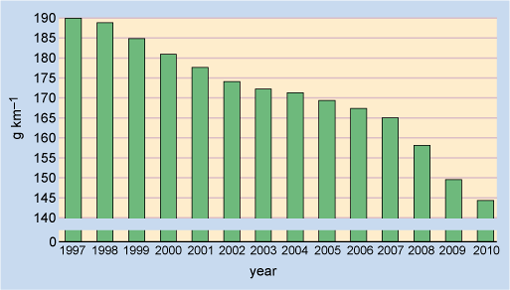4.3 CO2 regulation
For petrol and diesel cars, CO2 emissions are directly related to the fuel economy of a vehicle. Until recently, carbon dioxide emissions from vehicles were 'unregulated emissions', subject only to voluntary industry agreements. This changed in 2009 when the European Commission's car CO2 emissions regulation (EC443/2009) set a sales-weighted CO2 target for new passenger cars. The regulation specifies an average target of 130 g km−1 by 2015 (a 9.8% reduction on the 2010 level), proceeding to an average of 95 g km−1 by 2020.
Manufacturers will face significant fines if they fail to achieve their targets. These fines will be at a set rate per gram, multiplied by the number of cars registered. The fine rate will be €5 for the first gram over target, €15 for the second gram, €25 for the third gram and €95 for the fourth and any subsequent grams over target. So a manufacturer selling 1.5 million cars with an average CO2 emissions level of 131 g km−1 in 2015 will face a fine of €7.5m; if their level is 132 g km−1 they will pay an additional €15 per car, taking the fine up to €30m; and so on. This system is being phased in from 2012 and will be fully operational, with fines, from 2015.
There is also the temporary provision of supercredits for cars emitting 50 g km−1 or less. These very low-carbon cars will be multiplied up in the overall calculation, and so reduce the overall average for a manufacturer. They will be calculated as being equal to 3.5 cars each in 2012 and 2013, 2.5 cars in 2014, 1.5 cars in 2015 and then normally thereafter. This is to encourage car manufacturers to develop and promote these ultra low-carbon cars sooner rather than later. Certain innovative CO2-reducing technologies will also be granted credits.
In practice, in 2010 the average test CO2 emissions level of cars registered in the EU was 140 g km−1. In 2010, the UK average new car test CO2 emissions level was slightly above the EU average, at 144 g km−1, but this had dropped substantially from 190 g km−1 in 1997 and was at 165 g km−1 as recently as 2007 (Figure 4). In 2011 the UK average dropped further, to 138.1 g km−1.
As previously mentioned, all emissions and fuel consumption are as measured under test using the New European Driving Cycle (NEDC) and do not reflect real-world driving.

It appears that the EU target of achieving an average new car test figure of 130 g km−1 by 2015 is a real possibility, although this does depend on consumers being willing to accept smaller cars overall. However, there are also counter-trends: there is demand for more extra features within the vehicle such as air conditioning, heated seats, electric windows, auto-defrosting and on-board navigation, which all require energy to operate and can result in increased vehicle weight. In addition, the number of cars is increasing, as is peak engine power and the distance driven.
This all helps to explain the substantial gap between the reduction in new car test CO2 figures and total CO2 emissions from the car sector as a whole. For example, compared to 1997, in 2009 the UK's new car test CO2 emissions were over 20% lower but the amount of CO2 coming from UK cars as a whole had only dropped by 7%. There is a time-lag effect as the new, more fuel-efficient cars are introduced and old cars scrapped. But in addition to this, behavioural factors are seriously eroding the vehicle improvements.
Activity 4 (exploratory)
The UK has a legally-binding target to reduce all CO2 emissions by 80% by the year 2050, compared to 1990 emission levels. Would an 80% reduction in the car fleet's test CO2 emissions achieve this? If not, why not and what is needed to achieve an actual, real reduction to this level in CO2 emissions from cars?
Discussion
The CO2 emission performance of a car fleet is only part of what makes up the total emissions from the car sector. The total will be a function of the actual (not test) CO2 emissions per kilometre multiplied by the number of cars and the total distance driven (see Potter, 2007). So if the number of cars owned increases and the distance driven increases, an 80% cut in emissions per car will result in a less than 80% cut overall. The extra cars and driving behaviour counterbalance the reduction per car/km. This is why transport policies need to address both vehicle technologies and behavioural factors, with the latter affecting the distance driven and the mode choice (between car, train, bus, walk or cycle).
Broadly, looking at the historical data on reduction in test car CO2 emissions and reduction of CO2 emissions from cars as a whole, technical improvements need to deliver twice the overall CO2 reduction target to allow for on-road conditions and growth in travel and car use. Expressed in terms of test CO2 emissions, in 1990 (the base year for the calculations) the EU average for cars was around 190 g km−1. An 80% cut suggests a target of 38 g km−1, but if car ownership and distance driven both increase then to get a real overall cut of 80% in CO2 emissions, a test figure of about 20 g km−1 would have to be achieved.
Now, having looked at some of the issues around controlling and regulating the emissions of conventional petrol and diesel road vehicles, the rest of this free course will focus on ways in which these emissions can be reduced further: by improving existing technology, by using alternative fuels or by switching to electric vehicles. Each of these options has its own advantages and problems, as you will see.
